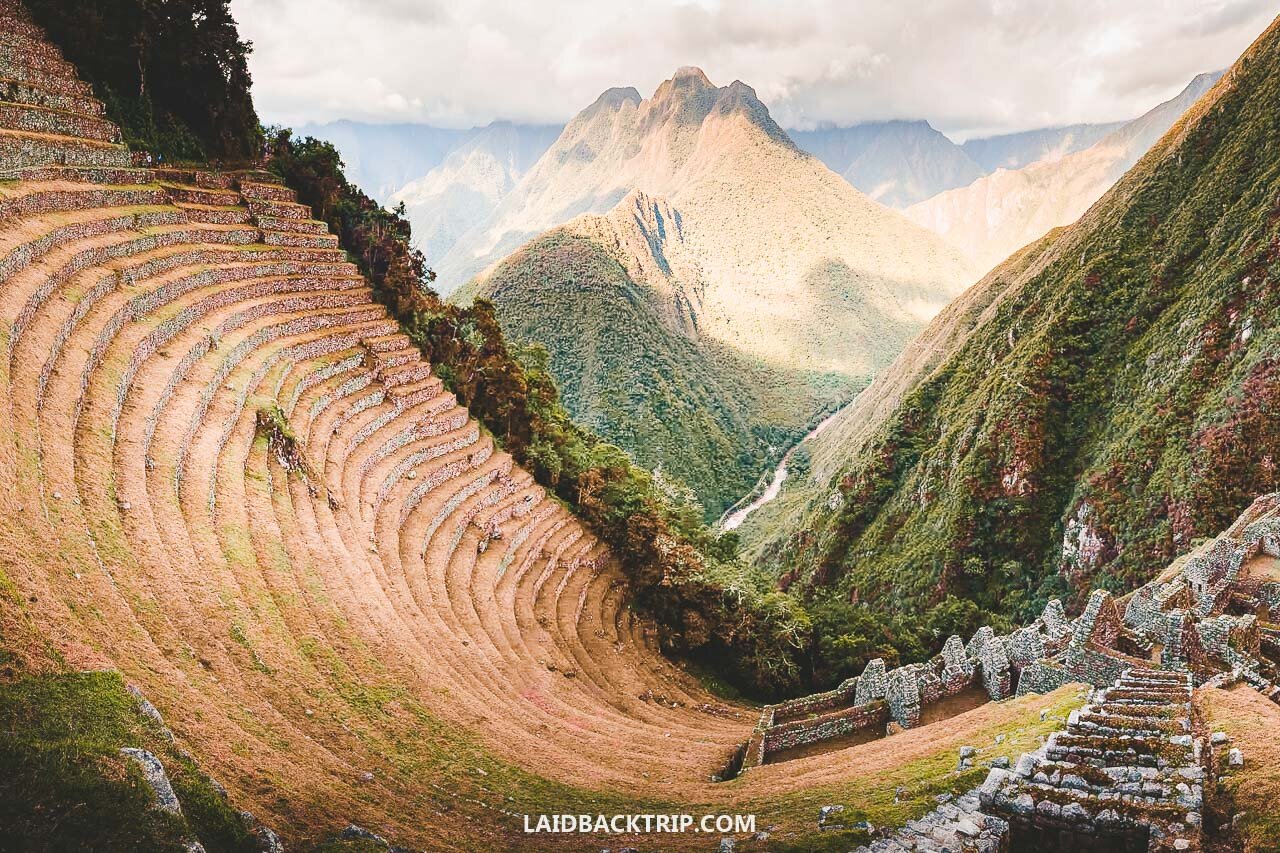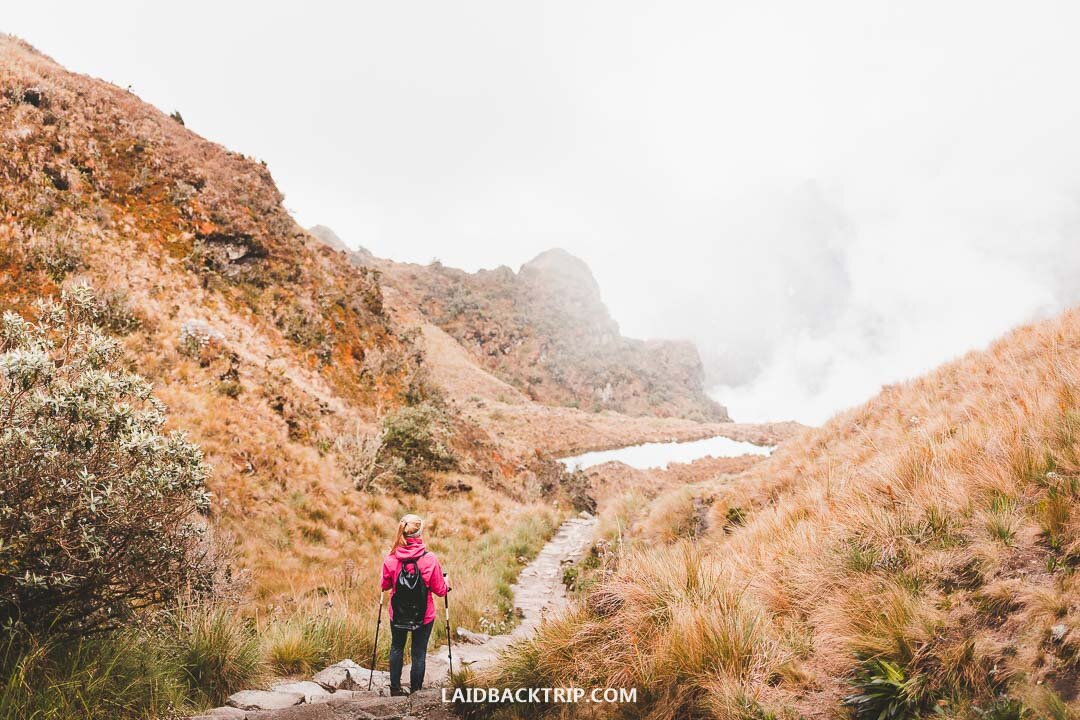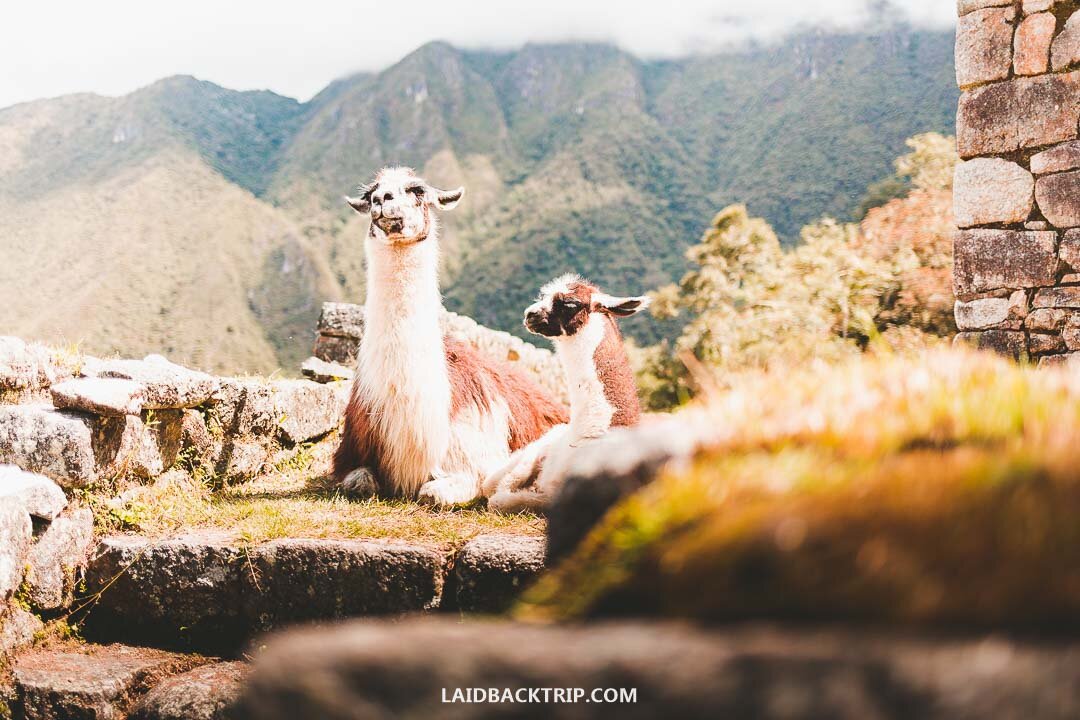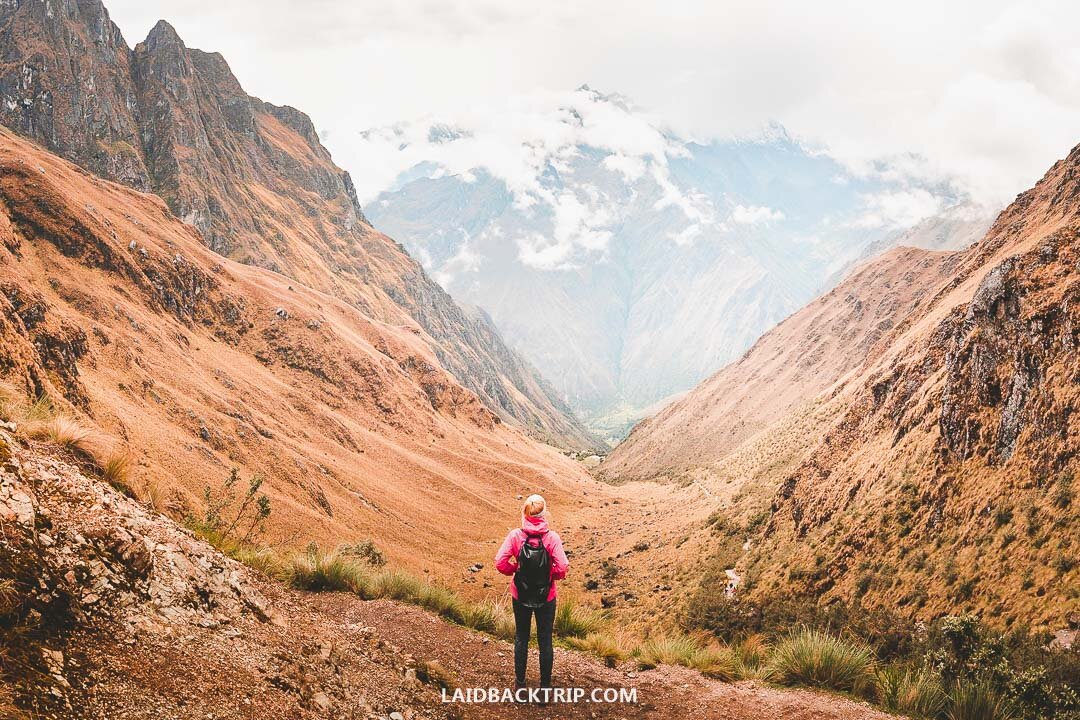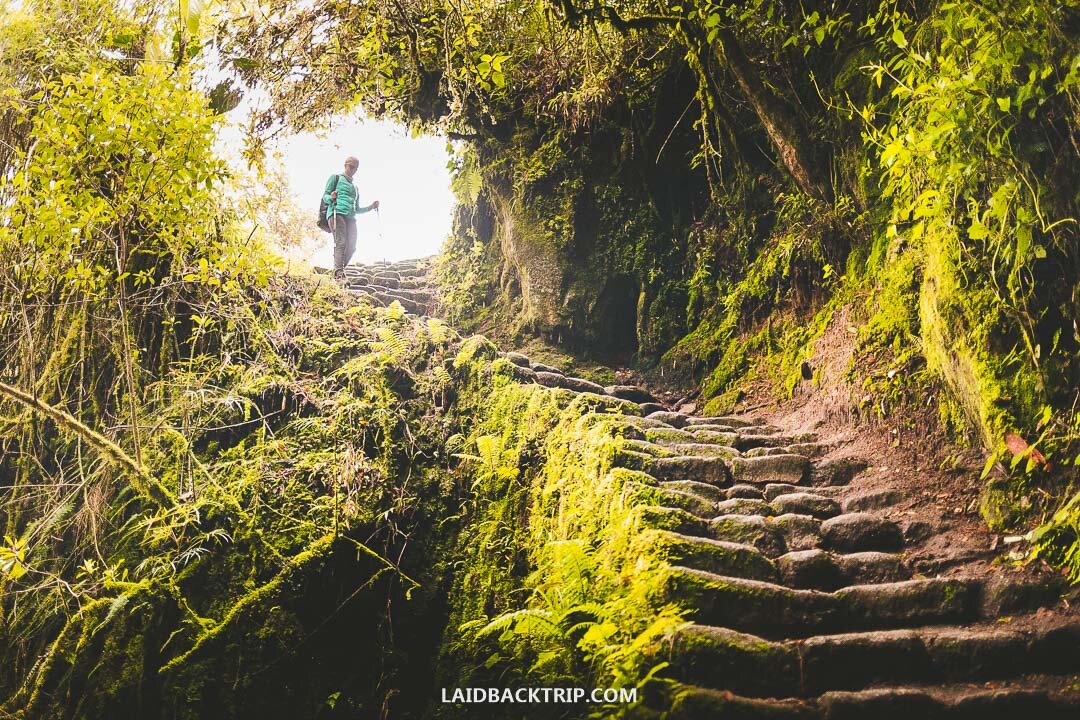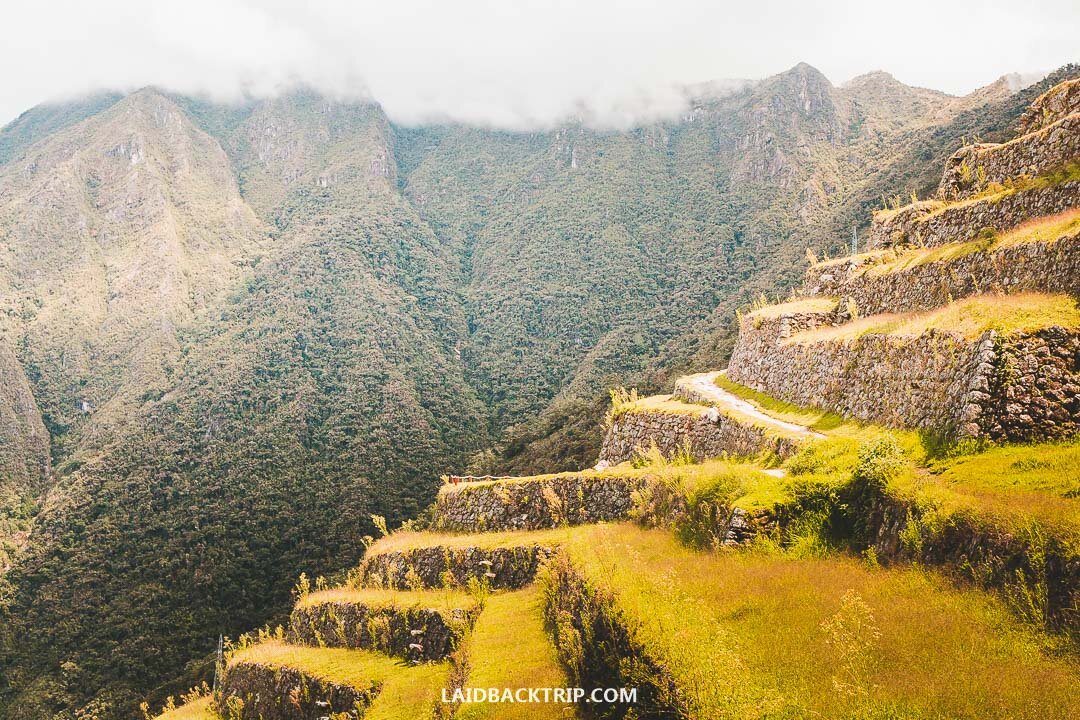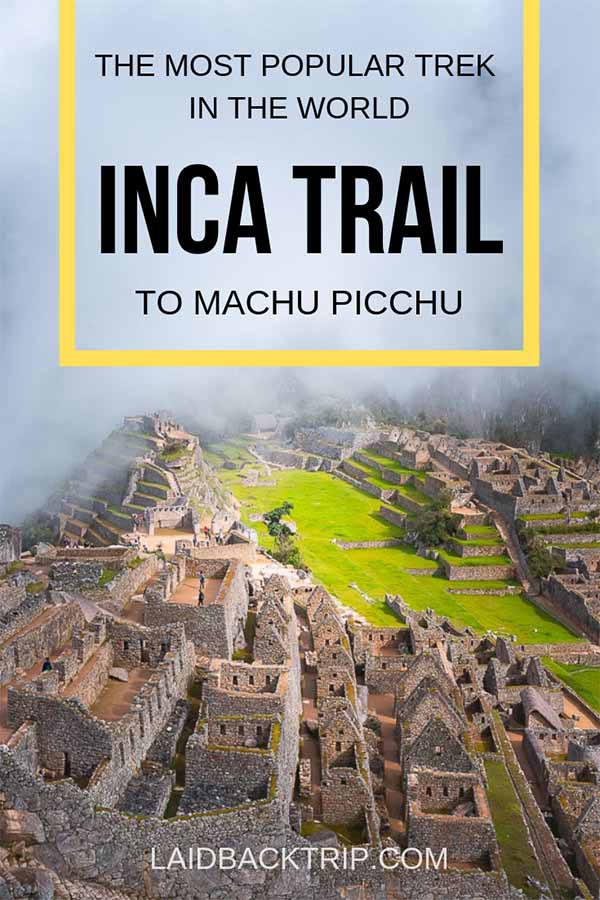A Complete Guide to Hiking the Inca Trail
Inca Trail is the most traditional hike to Machu Picchu. In this classic four day Inca Trail hiking guide, we share everything you need to know about trekking from Cusco and our experience with Alpaca Expeditions, a local Peruvian tour operator. Includes Inca Trail itinerary, trail description, length, ruins, altitude, what to pack, permit, and how to book in advance.
Inca Trail, the mysterious path leading from Kilometer 82 to the most iconic Inca site, Machu Picchu, belongs among one of the most well-known treks in Peru, South America, and, by extension, the entire world.
There's probably not a traveler to Peru who's never heard about the Inca Trail, and who at least for a brief moment, did not think how the hike could have been like.
But what are the features that set the Inca Trail apart?
Why is this trail so unique that even people who have never hiked a multi-day trek have it on their bucket list, and why the trek itself is booked out several months in advance? And why is Inca Trail considered to be one of the best treks in the world?
There are several reasons, based on our experience, why Inca Trail is that good.
It is the unusual combination of stunning nature, high mountains, the original stony path with many steps Incas used centuries ago, several beautiful ruins along the way, and then the spectacular archaeological site, Machu Picchu, standing peacefully at the end of this once in a lifetime pilgrimage.
The world-renown reputations and a touch of exclusivity are the reasons why even inexperienced hikers and campers desire to undergo four (or five) days of trekking and three (or four) nights sleeping in the tents.
So far, we've done a couple of multi-day hikes in the Cusco area, including the famous Salkantay Trek.
We love hiking, and we believe we can tell the difference between an average and an excellent hike - and the Inca Trail leading through stunning panoramas towards the ancient Inca city of Machu Picchu unquestionably belongs to the latter category.
In this hiking guide, we share our Inca Trail experience, including the facts, things you should expect and know before setting off, same as tips on what to pack or when to go.
INCA TRAIL HIKE
The Inca Trail is quite specific in terms of permits and reservation process, so you might be wondering whether this is the right trek for you.
One thing is certain. The Inca Trail, because of its popularity and many regulations from the Peruvian government side, doesn't belong among the world's cheapest hikes.
Only authorized and reputable travel companies with outstanding service and equipment can walk their customers through the path unmatched by any other.
No wonder we decided to team up with Alpaca Expeditions, the same tour operator we already had a perfect experience with from the Salkantay Trek, which has excellent reviews from thousands of customers, offers topnotch service, and still guarantees a reasonable price.
If you are not sure whether Inca Trail is the right trek for you, read our comparison of Inca Trail vs. Salkantay Trek and make the informed decision by yourself.
THE INCA TRAIL FACTS
The Inca Trail is 43 kilometers long and requires at least a moderate level of fitness.
The hike starts at Piscacucho, a place known as kilometers 82, and ends at the Sun Gate in the Machu Picchu archaeological site.
The classic Inca Trail is four days three nights long, but for those, who are not that fit, travel with kids or elderly or only want to spend more time on the path where the Inca himself, the nobility, and his servants walked to Machu Picchu, there is also the five-day option.
The highest point of the Inca Trail is the Dead Woman's Pass at 4215 meters. You are going to walk at a lower altitude for the rest of the hike.
Every day, be prepared to walk 6 to 9 hours; the most challenging day is 16 kilometers long.
The Inca Trail is unique in many ways, but what makes it so different from other hikes is the path itself and the number of ruins along the way.
The trail is made from stones and an uncountable number of stairs, so whether you have problems with your knees or not, we strongly recommend renting walking sticks.
Especially the third and the fourth day are challenging as the trail is 95% original from Inca's times, so some sections are rugged and slippery, but this is what makes the trek so unique, right?
DIFFICULTY
Inca trail is not the hardest trek in the world, but there are some difficult and steep parts. Except for the altitude, we found it the most challenging to climb the stone steps on the trail.
From our own experience, trekking poles are real lifesavers for anyone with bad knees.
As there will be hikers in your group with different fitness levels, guides always make sure that the group stays together (or the guide stays with you).
We felt that the guides did a great job of setting the pace of the group, so even the slowest members enjoyed the hike. There was no need to rush things; Inca Trail is truly beautiful.
Also, make sure to acclimate your body at Cusco before you go in order to enjoy the trip as much as possible.
LENGTH
As already mentioned, the classic 4D/3N Inca Trail hike is 43 kilometers long.
One important thing to know about Inca Trail is that each tour company in Cusco offers a few more hike alternations with varying lengths.
One of the best examples is the Inca Trail combined with Salkantay Trek. The 7-day 75 kilometers long version of this hike is quite popular.
In case you are short on time, you can hike the two-day Inca Trail version, which allows you to spend about six hours on the original trail before visiting Machu Picchu.
CROWDS
We were worried the Inca Trail might feel crowded as there would be 500 people hiking at the same time. During those four days, there were only two instances where we met a large number of hikers on the trail.
Not surprisingly, some groups arrived at a similar time to the first checkpoint on the trail. No big deal, though.
On the last day, we were waiting in line at the entrance gate for the Sun Gate trail to be open. As everyone wants to get to Machu Picchu as early as possible, the entrance felt quite crowded.
Other than that, our group was able to walk at our own pace and did not hike with the crowd.
Of course, you will see hikers at the campgrounds. But the campsites are spread out enough, and it didn't feel crowded.
ACCLIMATIZATION
It is impossible to write an Inca Trail hiking guide and not to mention the necessity of proper acclimatization. What does it mean?
If there's one thing you need to know, it is that Cusco, for many, the starting-off point sits 3400 meters above sea level, which is pretty high, especially for an unacclimated human body.
Take advantage of Cusco being a hot tourist spot. There are so many things to do in Cusco that the list of activities is almost endless.
Take it slowly, visit Sacsayhuaman Ruins, book a Sacred Valley Day Tour, and simply give your body some time to adjust to the thinner air.
As many of the day-trips from Cusco are in the altitude, your effort surely won't get wasted.
We believe hiking to Pisac Ruins or Humantay Lake helps a lot.
If you also want to visit Rainbow Mountain, we would be more cautious and maybe leave it for another day. You will hike to an altitude of 5000 meters above sea level, and that's not something you should take lightly.
There are a few simple tips on how to acclimatize. Be active, walk around the city, drink a lot of water, avoid alcohol, eat light meals, and simply breathe.
WHERE TO STAY IN CUSCO
When selecting a hotel where you'll spend the night before or after the Inca Trail, consider a few things.
First of all, you'll most likely need to leave some stuff you do not want to carry in the hotel. This means you should book a place that seems safe and reliable.
Second, this time, you might prefer a comfortable hotel as we really looked forward to staying in a nice hotel room after four days in the tent.
Cusco is one of the top tourist destinations in Peru, so worry not - you'll surely find a hotel that suits your budget and travel style. Get inspired down below.
Budget | Cusco Bed and Breakfast - Spacious and clean rooms, comfortable beds, very quiet at night, excellent location.
Mid-range | Tierra Viva Cusco Centro - Providing a tranquil environment, beautiful rooms and also has one of the top-rated locations in Cusco.
Luxury | JW Marriott El Convento Cusco - The hotel features impressive interiors, has a charming colonial courtyard, luxury rooms, and Cusco’s cathedral or main square is only three blocks away.
ALTITUDE
The highest point on the Inca Trail is Dead Woman's Pass, at an altitude of 4215 meters above sea level.
On top of that, you'll also sleep at a high altitude, although at lower elevations. "Climb high, sleep low" is one of the best ways to prevent altitude sickness.
It is better to be ready rather than not to be able to finish the hike.
Travel Insurance
We never leave home without travel insurance that was designed to cover our expenses if something goes wrong during the trip.
Travel insurance protects against theft, flight delays, injury, illness, cancellations, and much more.
For the Inca Trail, make sure your travel insurance covers hiking at high altitude (4000 meters above sea level).
World Nomads provides travel insurance for travelers to cover their trip essentials, including sports and adventure activities.
SafetyWing is affordable travel insurance for backpackers, long-term travelers, and digital nomads.
Travel smarter and safer!
THINGS TO KNOW
It's been said many times, and we'll repeat it. Inca Trail cannot be walked independently, so step number one is choosing a travel company. In this guide, we share information based on our hiking experience with a local company, Alpaca Expeditions.
Alpaca Expeditions always organize a briefing a day before the trek starts to ensure all hikers arrived in Cusco safely and all are feeling well.
During the briefing, you will also meet your fellow travelers for the next couple of days, your guides who explain the itinerary in detail and give you duffel bags where you should pack your stuff that will be carried by porters later.
In case you can't make it to the office that day, you can stop by anytime before the trek during the office's opening hours.
Also, you don't need to stay in Cusco the day before departure as the bus can pick you up in either Urubamba or Ollantaytambo, so you can plan your time efficiently as it works for you the best.
One more thing to know before you go. You need to carry your passport for the Inca Trail. Don't leave it at your hotel. Also, keep it dry and safe.
THE INCA TRAIL ITINERARY
We hiked the classic four-day Inca Trail itinerary that ends at Machu Picchu.
In case you choose to hike with a different company, you will follow the same path as other tours. Simply put, there is only one way to follow. The stops, breaks, and camping spots may differ slightly.
Apart from the first day when we hiked through a few villages, you won't meet any people going the opposite direction (only when they decide to give up).
DAY 1: CUSCO - KILOMETER 82 - AYAPATA
The first day of the Inca Trail started very early in the morning in Cusco. Our guides picked us up at 4:15 AM at our hostel.
We were the first ones on their schedule, so then we drove around the Cusco to pick up other hikers from our group who stayed in different hotels.
We got a warm blanket and slept until we stopped for a short time in Ollantaytambo, where we could use the bathroom or buy water.
Then we arrived at kilometer 82, where we had breakfast, gave our duffel bags to porters, and after a short stop in an interpretation center focused on flora, fauna, and architecture along the trail; we started our hike.
Not far away was a checkpoint, where we had to show our passport and the permit to hike the Inca Trail (you will receive it from your guides on the spot).
Then we crossed a bridge and finally started to believe we would hike the famous Inca Trail.
The first part of the trek was easy, relatively flat, and the first uphill climb waited for us after two hours when we reached the Patallacta ruin.
From here, the path led up and down (so-called Inca flat) to our lunch spot.
On the way, we could see beautiful mountains and local people from nearby villages who work mostly in agriculture.
This section is also the only one where it is allowed to use horses for transport (only for locals or in case of emergency); otherwise, everything needs to be carried by men.
After lunch, we hiked uphill to our first campsite Ayapata, a place with a beautiful view of the surrounding mountains that were soon hidden behind clouds rolling from the valley.
DAY 2: AYAPATA - DEAD WOMAN'S PASS - RUNCURACCAY PASS - CHAQUICOCHA
The second day was the longest and hardest one on Inca Trail as we had to conquer two passes.
We woke up before 5 AM, and about 6:30 AM, we started our four hours hike to the highest point of the trek, the Dead Woman's Pass.
In the beginning, we walked in the rain, but the path led through the thick forest. Trees covered with moss reminded us of our travels and beautiful hikes in New Zealand.
The uphill climb is moderate except for the last steep section.
Despite the morning rain, we had an astonishing view from the pass, where we spent about half an hour.
Then we descended to our lunch spot, and later, after about a half an hour break, we started to ascend to another pass Runcuraccay, which fortunately lies lower than Dead Woman's Pass (around 4000 meters).
Along the way, we also visited another Inca site Runcu Raccay.
When we made it to the top, we were unfortunately in the clouds, so we started another long descend to our campsite Chaquicocha alias Dry Lake, but we stopped at another ruin along the way, Sayacmarca.
We came to our campsite just before sunset and couldn't wait to have some hot drinks, popcorn, and dinner.
DAY 3: CHAQUICOCHA - WINAY WAYNA
The last full hiking day is the shortest but still requires some walking.
Alpaca Expeditions made a great decision to camp at Chaquicocha the day before, so it means we arrived at the last campsite Winay Wayna at lunchtime, and we could rest in the afternoon for a while before the most anticipated day.
But we also had to get up quite early, about 5 AM.
When we woke up, we could have seen several snowcapped mountains around but were not lucky enough to have those views for the whole day as the thick cloud started rolling from the valley and hid everything under its blanket.
From that moment, we had only sporadic views, but it was pretty exciting to wait for the cloud to cease and show us the beauty around.
The last day hike is the easiest as the path is flat or goes downhill.
Also, on that day, we could have walked the most original and the best-preserved section of the whole Inca Trail.
Along the way to our campsite, we stopped at two notable Inca sites - Phuyupatamarka and Intipata.
When we arrived at our campsite, we had lunch, short rest, and in the afternoon, we visited the last archaeological site before Machu Picchu, Winay Wayna, which is also nicknamed a small Machu Picchu.
After, we had the last dinner, said farewell to our whole team - to 21 porters and one chef who did everything they could to make us feel comfortable - and then went to the tent early.
DAY 4: WINAY WAYNA - SUN GATE - MACHU PICCHU - AGUAS CALIENTES - CUSCO
There was a reason to go to bed early the night before. Our alarm clock rang at 3:15 AM, and we had only twenty minutes to get ready.
Why the rush?
Only five minutes from the campsite is the last checkpoint on the Inca Trail. There is a small shelter with wooden benches, and only a few (probably four or five) first groups fit in; the rest must stay outside and wait for the checkpoint to open.
We had a boxed breakfast with us to pass the time, and on top of that, our porters brought us hot tea, so the waiting wasn't unpleasant at all.
Strictly at 5:30 AM, the gate opened, and all groups one by one could enter the last part of the Inca Trail, the path to the Sun Gate. We were a bit surprised by how our group was pacing.
Until that moment, all our fellow hikers were not particularly fast, but it seemed that they saved the last bit of energy for the last hour of hike, and their motivation to be the first at the Sun Gate was incredible.
We walked fast with them (because we did not want to be overtaken by groups behind us), but honestly, it did not make any sense for us, as it was cloudy and it rained all night.
The path that leads to Sun Gate is almost flat, except for the last steep section with several steps.
After about an hour, we arrived at Sun Gate, where we waited for a bit for the cloud to disappear, and although we couldn't see the first sun rays touching Machu Picchu, we actually got a nice view.
Later we finally descended to Machu Picchu.
Here, we can guarantee you one thing. No matter how many times you've seen pictures of Machu Picchu before, you will be utterly amazed by the size and the scenic settings of this archaeological site.
When we took enough photos from the most famous viewing platform, we had a two-hour-long guided tour.
During this time, our guides explained the history and pointed out all the important facts about Machu Picchu.
When our time was up, we had to leave the grounds and waited for a bus which took us to Aguas Calientes where we had lunch and then waited for a train which took us to Poroy, a small village, 30 minutes drive from Cusco.
Here Alpaca Expeditions' bus waited for us and brought us to our hotel. We arrived at 7:30 PM, so it was a long and busy day, but we will never forget it.
RUINS ON THE INCA TRAIL
Although the highlight of the Inca Trail is Machu Picchu, a UNESCO site which is very hard to compete with, there are several ruins along the way which are worth pointing out.
We knew that we would see several ruins along the Inca Trail, but honestly, we didn't do any research as we wanted to be surprised.
It happened to us too often while traveling that so-called ruins turned out to be only a couple of stones piled up.
That's why we can't even describe how surprised we were by ruins along the Inca Trail. They are large, well-preserved, and surrounded by a stunning landscape.
Let's say Incas knew where to find the best views!
Here's a brief introduction of sites you can visit along the Inca Trail. If you still hesitate whether the Inca Trail is worth it, we can say that it is the ruins that distinguish the trek from others.
PATALLACTA
A stunning site only two hours hike from the trailhead Kilometer 82.
This site was discovered in 1912 when Hiram Bingham (an explorer who rediscovered Machu Picchu) stumbled upon it when he hiked the trail in the opposite direction - from Machu Picchu to Kilometer 82.
Patallacta is an ancient Inca checkpoint overlooking the valley and Cusicancha River.
From the Inca Trail, you will be able to appreciate the site's massive terraces and beauty fully.
RUNCU RACCAY
You will come across those ruins on the second day when ascending to Runcuraccay Pass.
This site is a bit different because of its structure and shape, and it probably served as a resting and refueling place for people (and animals) on their pilgrimage to Machu Picchu or for messengers running across the Inca empire to deliver messages.
SAYACMARCA
Only 20 minutes from the second campsite lies another impressive ruin Sayacmarca.
After the long day, we had to force ourselves to climb another 98 vertical stone steps carved into the side of the mountain, but we are glad we did.
Sayacmarca is also known as an Inaccessible Town, but this site's main purpose is still cloaked in mysteries until today.
PHUYUPATAMARKA
Another site along the Inca Trail, Phuyupatamarka, lived up to the expectations as in the Quechua language it exactly means Town in the Clouds.
For us, the Urubamba Valley views remained hidden, but we could admire the site's structure, and our knees will surely remember the descent for a long time.
INTIPATA
In translation, Intipata means Terraces of the Sun, and again we could see where the name came from. The site is immense and contains many terraces but no plaza or religious structures.
Inca people were masters in agriculture, and this place probably served as a spot for plant domestication and cultivation.
Because Incas did not leave any writing records, we can only guess the real purpose, but one thing is undeniable. This ruin is magnificent.
WINAY WAYNA
Winay Wayna is the most spectacular site after Machu Picchu in the area and is also the most popular as it lies only about five minutes walk from the last campground.
That's why people who finished the Inca Trail like to spend there the afternoon leisurely walking around or just sitting on terraces while relaxing and enjoying splendid views.
The name Winay Wayna means Forever Young.
Because of the extensive complex and baths, it is believed that this place was the last point on the way to Machu Picchu, where people might have cleaned themselves before entering the Sacred City.
Winay Wayna was also the place where we realized the exceptionality of the trail connecting the Sacred Valley with the Lost City.
In general, the ruins along the trail are accessible only to a limited number of hikers, which is another point for including this trek in your Peru travel itinerary.
INTI PUNKU
If this name doesn't ring a bell to you, what about Sun Gate?
One of the most famous structures on the way to Machu Picchu is by no means that impressive as other ruins we've seen on the Inca Trail, but it is the place from where travelers hiking the Inca Trail can get the first glimpse of Machu Picchu (when it is not foggy).
Sun Gate was once the main entrance and exit to and from Machu Picchu.
People who were guarding the gate controlled all people as not everyone could have entered the sacred sanctuary.
MACHU PICCHU
At the end of the Inca Trail, Machu Picchu, one of the new world's seven wonders is waiting for you in all its splendor.
Machu Picchu was constructed in the 15th century but was abandoned in a rush only a century later when Spanish conquerors arrived in Peru.
The site was not unknown to local people (two families lived and farmed there before the 'official' discovery).
Still, Machu Picchu's glory remained hidden to the entire world until 1911, when an American historian and explorer Hiram Bingham rediscovered it and brought it to international attention.
The whole site consists of about 200 structures, and one of the most important buildings is the circular Temple of the Sun.
To learn more, read this super informative guide: Everything You Need to Know Before Visiting Machu Picchu.
When looking at the Machu Picchu (and we leave all speculations about its purpose aside), it is incredible to imagine that people could build the site only with their bare hands.
The surrounding mountains and hills are stunning, and if you ask us why Inca people chose to build their sacred city here, we would reply: because of those views.
CAN YOU HIKE THE INCA TRAIL WITHOUT A GUIDE
If you are an experienced hiker, you are probably looking for information if it is possible to hike the Inca Trail independently.
Unfortunately, the answer is no.
Since 2001, the Peruvian government set strict regulations and rules, and it is impossible to trek the original Inca Trail leading to Machu Picchu without a guide or tour operator.
But in this case, we believe it was a wise decision. Why? The answer is simple.
At the end of the 20th century and the beginning of the 21st century, when the Inca Trail was already recognized among the most beautiful treks in the world, the path from the 15th century started to become a victim of its popularity.
Injuries, altitude sickness of unaware tourists, crowded narrow paths, and trash along the way - this was the everyday reality.
Those are factors why the Peruvian government decided to step in.
Nowadays, only 500 permits are issued daily. But it doesn't mean you will meet another 499 hikers along the way.
All staff, including guides, porters, and chefs, must have the permit as well. It is estimated that out of 500 spots, only 220 take actual hikers; the rest go to the staff.
You might ask why there are so many porters needed. In contrast with other alternative treks to Machu Picchu or the Sacred Valley, tour operators cannot use horses to carry all the equipment.
Inca Trail is a logistically challenging trek, and based on our experience, we think that the rules applied did only good to this unique part of the world.
Sure, it means the hike is more expensive, but on the other hand, there's probably no other way how to regulate the number of people.
HOW FAR IN ADVANCE SHOULD YOU BOOK THE INCA TRAIL
Short answer? You need to book the Inca Trail on average six months in advance, depending on the season.
Hiking the Inca Trail is on almost every travelers' bucket list. Now when we explained that the '500 permits' limit doesn't apply only to trekkers but also to all support staff required, no wonder that permits sell out fast!
In the case of booking the Inca Trail, sooner always means better.
Travelers who consider hiking in the main season (from June to September) should reserve their spot nine months up to one year in advance! Yes, we know it is way too long, especially if you're a long-term traveler, but this is how it is.
But even in the shoulder season or rainy season, you should not count on your luck as everyone should book at least three to four months in advance to get the spot.
PERMITS
In order to hike the Inca Trail, you need to obtain trekking permits first. You can obtain your permit by contacting a licensed Inca Trail Tour Operator who will get the tickets and arrange everything necessary for the hike on your behalf.
Choosing a reliable and trustworthy tour operator for Inca Trail is essential. Unfortunately, there is not even an official site where you could check availability on your selected dates.
You probably noticed that when it comes to the Inca Trail, demand exceeds supply multiple times. That's why it is also necessary to choose a tour operator with extensive experience with securing tickets.
Alpaca Expeditions has 95% efficiency in securing clients' first date preferences and overall 99% efficiency as they always require another two alternative dates their clients can start the trek.
BEST TIME TO HIKE THE INCA TRAIL
You can trek the Inca Trail any time of the year with an exception of February. The rains are heaviest in February, and that's why the Inca Trail is closed for maintenance.
But if your main reason to hike the Inca Trail is to see Machu Picchu, do not despair; this iconic archaeological site is open all year round.
Peru has two distinct seasons - dry and rainy.
In the Cusco area, the dry season is from May to October, when you have a high chance to enjoy the sunshine and clear skies but be prepared to share all the beauty with many visitors. Temperatures are also lower as it is the Peruvian winter.
The rainy season starts in November and ends in April, but no worries, it doesn't rain every day or all day long all the time. You still have a chance to enjoy lovely sunny days.
November and April can usually turn either way, but you should not experience day-long downpours as in February.
In the shoulder or low season, you can enjoy pleasant temperatures and also many photogenic opportunities.
HIKING THE INCA TRAIL WITH ALPACA EXPEDITIONS
Thanks to its position near the mysterious Sacred Valley, the iconic Machu Picchu, beautiful mountains, and incredible hikes (including one of the world's most famous trek, the Inca trail), Cusco became the Peruvian center of tourism.
With a good conscience, we are not afraid to say that you would have a hard time to search a traveler who doesn't have Cusco on his or her bucket list.
The competition is immense, and finding a good travel operator can be a daunting task, especially when you plan on hiking the Inca Trail.
That was why we teamed up with Alpaca Expeditions, the number one tour operator in Cusco and 100% Peruvian company.
Not only because of the perfect service, excellent food, great equipment or knowledgeable guides (although it is a huge factor why to hike with this company, and we don't take it for granted) but also because this company goes much further to make their business sustainable and to differentiate themselves from other tour operators on the market.
Supporting local tour operators is one of the ways to travel sustainably.
Social projects | Alpaca Expeditions runs several social projects to help Andean communities. We must mention that the founder of Alpaca Expeditions, Raul, grew up in one of those communities and worked as a porter, so he knows very well what is needed and the biggest struggles of people living in those remote areas.
That's why he also focuses on porters' welfare. It is always important to take care of future generations; that's why many projects work with kids - they get school supplies or dental care, something so normal for us but so needed in those communities.
Also, did you know that the large percentage of people living in Cusco, Andean communities, or even porters who help hikers along the Inca Trail never visit Machu Picchu in their lives?
In February, when the trek is closed for maintenance, Alpaca Expeditions takes employees and their families to Machu Picchu. Something they can afford to do because of us, clients.
Satellite phones | When hiking in the mountains, one of the best things is to be disconnected from the entire world. But it is not that great when something happens, and you need to contact your doctor, family, or boss at work.
Alpaca Expeditions provides satellite phones to all their guides, so every group in the mountain can use them in case of emergency (or even if you only feel the need to get in touch with someone).
Women Empowering | It is not easy to find a job and feel welcomed in an industry where the collective is strictly formed by the men community.
It is much easier for companies to hire male guides or male porters because when you employ a woman, you need to use a different approach, and we don't talk about investments; you must teach your staff how to interact with ladies in the team.
Alpaca Expeditions decided to break this taboo and employs women in the offices and outside, in the mountains as guides or porters. Women usually grew up in the communities near Cusco and never thought that they would interact with tourists from all around the world on a daily basis.
This opportunity gives them self-confidence and new impulses to self-educate and increase income, which goes back to their kids, who can only benefit from it.
Porters Welfare | For most of the hikers, the Inca Trail would be very hard to finish without porters who carry personal stuff for clients and tents, matrasses, sleeping bags, food, or cooking equipment.
Although hiking the Inca Trail without porters would be almost impossible (imagine that the group of 16 hikers has 22 porters who take care of them), it is not a rule that companies treat their employees well.
The company is aware that their porters' welfare is necessary for the success of the whole company.
Every single porter gets hiking boots and all hiking equipment, health, and social insurance. They carry five kilograms less than the limit (20 kg instead of 25 kg), eat the same food as travelers, and on top of that, they receive an above-average wage for their job.
Alpaca Expeditions also support communities where the porters come from - being a porter is a good job for people coming from the Andean communities, and it is great that there is a company that appreciates their hard work and effort to do as much as they can to make their clients happy.
EQUIPMENT
When hiking with a reputable tour operator, you don't need to worry about equipment as all tents, sleeping bags, air mattresses, or hiking poles are of premium quality.
Tents are included in the price (you will get a four men tent only for two people, so there is enough space for you and all your stuff), and you can rent other equipment for a small additional fee.
FACILITIES
Facilities along the Inca Trail are pretty simple. There are several public bathrooms, but the capacity is not enough for such a large number of hikers, porters, and guides.
Alpaca Expeditions is aware of this problem and provides their customers on the Inca Trail with their own portable toilet (one for ladies and one for gentlemen), which is available only for hikers in the group at lunchtime and later in the campsite.
We can't even say how jealous other hikers were (some even unsuccessfully tried to sneak out into our toilet tent).
There is no shower along the Inca Trail except for the last camping place, Winaywayna, where it is possible to take a cold shower in one of the newly built facilities.
Although there is no shower on the first and the second night, our porters always brought us a small bucket with hot water to our tent so we could wash ourselves a bit.
We had our private dining tent to enjoy breakfast, lunch, and dinner to enjoy all our meals inside.
INCA TRAIL GROUP SIZE
The maximum size of the open group can be 16 people.
In case you have a group of friends or a large family you would like to hike Inca Trail with (and without strangers), or you plan on hiking the Inca Trail for a special occasion, Alpaca Expeditions can arrange a private service for you and your friends or family.
We would say that the limit is pretty reasonable. The group is not too small and not too big so that everyone will feel comfortable.
FOOD & DRINKS
As we mentioned before, we already hiked the Salkantay Trek with Alpaca Expeditions, so this time we knew what to expect in terms of food, and we looked forward to it.
All meals, breakfasts, snacks, lunches, popcorn during happy hours, and dinner were delicious.
You can always choose from several options, and we couldn't believe that our porters carried all the food along the whole Inca Trail, plus that the chef was able to cook such tasty food in rather challenging conditions.
The biggest surprise was that he even baked a cake for honeymooners in our group!
In case you have any food allergy or don't eat meat, milk products, or any other types of food, do not forget to mention it at the Alpaca Expeditions' office - reservations coordinators will ensure the chef will cook meal according to your requirements.
Drinkable water is provided from the first lunch until the last dinner.
Apart from that, we were every day woken up by our porters who brought us hot coca tea. During all the meals we could have enjoyed tea, coffee or hot chocolate.
GUIDES & PORTERS
Every company is only that good as its worst employee. We understood from all guides and porters that they are proud to work for Alpaca Expeditions, and we could feel their enthusiasm to do their best every day.
Porters and chefs were quick, efficient while guides were knowledgeable and entertaining for all four days.
From our own experience, we can tell how hard it sometimes can be to work in hospitality, but they were always professional and helpful.
WHAT TO PACK
Because of changes in altitude and climates, packing for Inca Trail is not that easy, and you'll need a bit of everything to be ready for severe weather conditions.
Pack lots of layers. T-shirts, shorts, leggings, underwear, socks, etc.
Otherwise, bring a down jacket, long-sleeved t-shirt, and hiking pants to have something warm to wear in the camp.
From gear, you will need broken in hiking boots, flip-flops, headlamp, rain poncho, rain jacket, a bottle of water, and a comfortable daypack (20-30 liters should be more than enough).
Don't forget your passport! And keep it in a waterproof case or dry sack.
There are several checkpoints along the way, plus you must show your passport at the entrance to Machu Picchu (and you can also get a Machu Picchu stamp in your passport if you wish).
We also highly recommend renting or bringing your own trekking poles. I have bad knees, and to be honest, I don't know how I would have finished the trek without it.
Make sure you check out our ultimate tried and tested Inca Trail Packing List, including all essentials you must have with you for this once-in-a-lifetime adventure.
ALPACA EXPEDITIONS INFORMATION
For information about the Inca Trail or other treks in Cusco, check out the Alpaca Expeditions website.
To make an inquiry, fill out this contact form or send them directly an email.
This post was written in collaboration with Alpaca Expeditions. As always, all opinions are our own.
Travel Resources
Here you can find links to all the travel resources we use and which you might find helpful when planning your next holiday.
Accommodation: When looking for accommodation, we usually search hotels via Booking.com or Hostelworld.
Tours: Although we love to travel independently, some places are better to visit with a guided tour.
We prefer GetYourGuide for its easy-to-use interface and solid reputation. Another great alternative is Viator.
Rental Cars: When going on a road trip, we always use Rentalcars.com, a reliable site for booking a rental car in advance.
Flight Tickets: When looking for flight tickets, you can search Skyscanner to find the best price.
Travel Insurance: World Nomads and SafetyWing cover against risks of travel.
